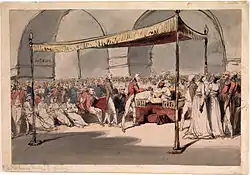Carnatic Treaty
The Carnatic Treaty was signed on 26 July 1801.[1] It is a treaty between the Nawab of Arcot and the East India Company. It is one of the treaties by which the British Empire acquired its rule over the Indian subcontinent or later known as British India. The treaty entailed that the Nawab was to cede the districts of North Arcot, South Arcot, Tiruchirappalli, Madurai and Tirunelveli to the company, and transfer all the administrative powers to it.[2]

Background
The treaty resulted in the liquidation of all the local chieftains of Tamil Nadu and The East India Company assumed direct control over Tamil Nadu. The Palayakkarar system came to an end as they had to demolish all forts and disband their armies. It resulted in the Company having full command over the region.[3][4]
Consequences
Based on the terms of the treaty, the Nawab of Arcot (sometimes called the Nawab of the Carnatic) ceded all his lands to British rule, including the territory of the polygars. He was retained one-fifth of the revenues of the country, amounting to 12 lakhs p.a in exchange.[5]
Literature
- John Malcolm (1826). The Political History of India, from 1784 to 1823, Volume 1.
References
- Rajayyan, K. (1970). "British Annexation of the Carnatic, 1801". Proceedings of the Indian History Congress. 32: 54–62. ISSN 2249-1937. JSTOR 44138505.
- John Malcolm (1826). The Political History of India, from 1784 to 1823, Volume 1. p. 1.
- Rajayyan, K. (1970). "British Annexation of the Carnatic, 1801". Proceedings of the Indian History Congress. 32: 54–62. ISSN 2249-1937. JSTOR 44138505.
- "Importance of the Treaty of 1801 - Social Science". www.shaalaa.com.
- Commons, Great Britain Parliament House of (1861). Parliamentary Papers. H.M. Stationery Office. p. 57.